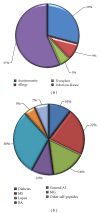A comparison of epitope repertoires associated with myasthenia gravis in humans and nonhuman hosts
- PMID: 23243503
- PMCID: PMC3518085
- DOI: 10.1155/2012/403915
A comparison of epitope repertoires associated with myasthenia gravis in humans and nonhuman hosts
Abstract
Here we analyzed the molecular targets associated with myasthenia gravis (MG) immune responses, enabled by an immune epitope database (IEDB) inventory of approximately 600 MG-related epitopes derived from 175 references. The vast majority of epitopes were derived from the α-subunit of human AChR suggesting that other MG-associated autoantigens should be investigated further. Human α-AChR was mostly characterized in humans, whereas reactivity primarily to T. californica AChR was examined in animal models. While the fine specificity of T-cell response was similar in the two systems, substantial antibody reactivity to the C-terminus was detected in the nonhuman system, but not in humans. Further analysis showed that the reactivity of nonhuman hosts to the C-terminus was eliminated when data were restricted to hosts tested in the context of autoimmune disease (spontaneous or induced), demonstrating that the epitopes recognized in humans and animals were shared when disease was present. Finally, we provided data subsets relevant to particular applications, including those associated with HLA typing or restriction, sets of epitopes recognized by monoclonal antibodies, and epitopes associated with modulation of immunity or disease. In conclusion, this analysis highlights gaps, differences, and similarities in the epitope repertoires of humans and animal models.
Figures






Similar articles
-
Suppression of experimental autoimmune myasthenia gravis by epitope-specific neonatal tolerance to synthetic region alpha 146-162 of acetylcholine receptor.Clin Immunol Immunopathol. 1993 Mar;66(3):230-8. doi: 10.1006/clin.1993.1030. Clin Immunol Immunopathol. 1993. PMID: 7679342
-
Determinant selection in murine experimental autoimmune myasthenia gravis. Effect of the bm12 mutation on T cell recognition of acetylcholine receptor epitopes.J Immunol. 1991 May 1;146(9):2977-82. J Immunol. 1991. PMID: 1707927
-
On the initial trigger of myasthenia gravis and suppression of the disease by antibodies against the MHC peptide region involved in the presentation of a pathogenic T-cell epitope.Crit Rev Immunol. 2001;21(1-3):1-27. Crit Rev Immunol. 2001. PMID: 11642597 Review.
-
T cell epitopes in experimental autoimmune myasthenia gravis of the rat: strain-specific epitopes and cross-reaction between two distinct segments of the alpha chain of the nicotinic acetylcholine receptor (Torpedo californica).Eur J Immunol. 1988 Apr;18(4):551-7. doi: 10.1002/eji.1830180410. Eur J Immunol. 1988. PMID: 2452743
-
Factors that determine the severity of experimental myasthenia gravis.Ann N Y Acad Sci. 1998 May 13;841:262-82. doi: 10.1111/j.1749-6632.1998.tb10935.x. Ann N Y Acad Sci. 1998. PMID: 9668247 Review.
Cited by
-
Immune Repertoires in Various Dermatologic and Autoimmune Diseases.Genes (Basel). 2024 Dec 11;15(12):1591. doi: 10.3390/genes15121591. Genes (Basel). 2024. PMID: 39766858 Free PMC article. Review.
-
A Sensitive Method for Detecting Peptide-specific CD4+ T Cell Responses in Peripheral Blood from Patients with Myasthenia Gravis.Front Immunol. 2017 Oct 24;8:1370. doi: 10.3389/fimmu.2017.01370. eCollection 2017. Front Immunol. 2017. PMID: 29114250 Free PMC article.
References
-
- Suljic E, Kavazovic A, Loncarevic N. How the application of human immunoglobulin in the treatment of myasthenia crisis changed the outcome of the disease. Medicinski Arhiv. 2010;64(1):7–10. - PubMed
-
- McGrogan A, Sneddon S, De Vries CS. The incidence of myasthenia gravis: a systematic literature review. Neuroepidemiology. 2010;34(3):171–183. - PubMed
-
- Shelton GD. Acquired myasthenia gravis: what we have learned from experimental and spontaneous animal models. Veterinary Immunology and Immunopathology. 1999;69(2–4):239–249. - PubMed
-
- Lindstrom J, Shelton D, Fujii Y. Myasthenia gravis. Advances in Immunology. 1988;42:233–284. - PubMed
LinkOut - more resources
Full Text Sources
Research Materials

